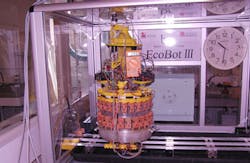British researchers from Wessex Water and the Bristol Robotics Laboratory have developed a new robot that processes human waste to extract microbes from feces and create electricity from the wastewater it purifies. Designing, assembling and launching the robot into action took researchers almost three years. Dr Ioannis Ieropoulos, a senior researcher at the Bristol Robotics Laboratory, said that EcoBot III was the first ever robot to use human waste in such a way.
The new robot is currently in its experimental stage. However, it is hoped that eventually it could be used in large-scale water treatment. The EcoBot III is multi-functional because it removes waste and cleans the water, while transforming the biomass it extracts into energy it then uses to carry on its functions. Scientists explained that the robot even has its own artificial stomach where the waste is processed.
RELATED: Microsoft data center to utilize sewage-fueled power plant
According to Dr. Julian Dennis, director of innovation and research for Wessex Water, treatment processes at present are very energy-intensive but researchers are working to replicate the EcoBot III on a larger scale in order to allow some processes to be powered on the sewage they are treating. High power consumption is one of the main problems with conventional water treatment facilities, but the use of the robot could eliminate the need for electricity altogether. Researchers hope that one day their technology would make it possible for water treatment to become entirely self-sufficient, thus reducing both operational costs and carbon footprint, the Nanowerk website reported.
The robot is part of a bigger project for the development of microbial fuel cell technology at the Bristol Robotics Laboratory, funded by the Engineering and Physical Sciences Research Council (EPSRC), a British funding agency for research and training in engineering and the physical sciences. Currently, EcoBot III is working on an operation outside Bath, England. It weighs about six kilograms and its creators liken its appearance to a three-tiered wedding cake. It consists of layers of microbial cells, catchment trays and fly trapping equipment that is linked to the artificial stomach.
Meanwhile, the race for sustainable technology never stops. Last month another bioenergy project came into the spotlight, when software giant Microsoft announced it was was launching a pilot of its "Data Plant" project in Cheyenne, Wyoming, where a small-scale demonstration installation will be presented in March 2013.
The $5.5 million project aims to prove that data centers can manage without any need for electricity and can be fuelled by biogas. The gas is created with an anaerobic digester at the Dry Creek Water Reclamation Facility to power a 300-kilowatt fuel cell from FuelCell Energy and is a byproduct of waste from the water treatment plant.

